A little while back I shilled the then upcoming telegram chess tournament. It is now underway, and I played my first game this morning against a player named Zurichh. It took a while for us to organize the game, due to an almost 12 hour time zone difference, but we set the start of the match for 6:30 AM PST. I am happy to announce that fatigue was not a factor, and I got a very nice win in the opening round. You can find the game here.
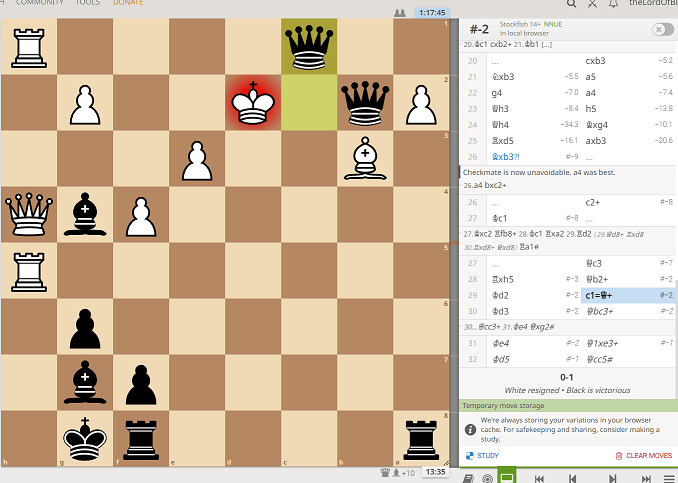
Above is the final position of the game, with my opponent resigning after 29: c1=Q+. The double check means that he can’t take the queen, and I was planning a mate in three afterwards. The computer tells me that there’s a mate in 2, but it’d be harder not to find a checkmate.
The time controls were 90|30, and you may have noticed the massive time discrepancy, with me having just 13 minutes left on the clock to my opponent’s more than an hour. I’ll get to that at the end.
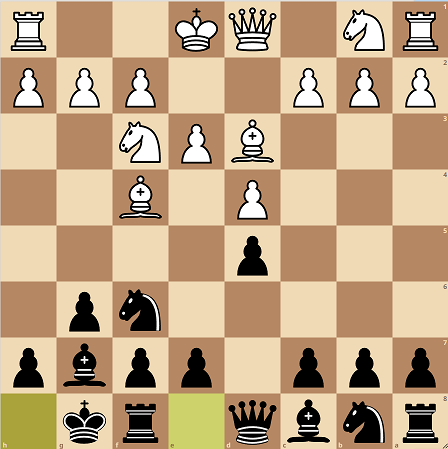
The game started off with a sort of Nimzo-Indian setup versus a London opening. I felt uncomfortable with the opening right from the very start, and wasn’t sure if my setup was getting me into trouble.
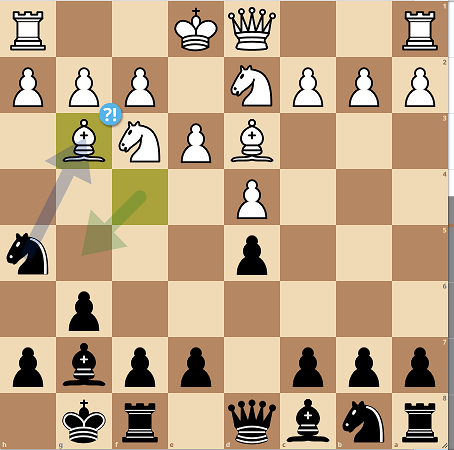
Despite my worries, the computer tells me that I actually had a respectable advantage after just seven moves. I had played the knight to the edge of the board to attack his bishop, and he played a natural move bringing it back to g3. The computer instead wants him to play g5, which I saw, but discarded. I was more worried about Be5, after which I had calculated a line that started with f6, and I believed to end with me having a comfortable position.
However, after he played Bg3 instead, I immediately made an inaccuracy by playing the fairly natural Nd7. I was worried about snapping off the bishop, since Nxg3, hxg3, might give him long term attacking chances after long castles. I figured that the bishop wasn’t going anywhere, and if he plays Bh4, that wastes a precious move when he isn’t castled, allowing me to strike with c5, getting a nice position. But the computer likes the move Bh4 anyway, and tells me that I suck for not just taking the bishop immediately.
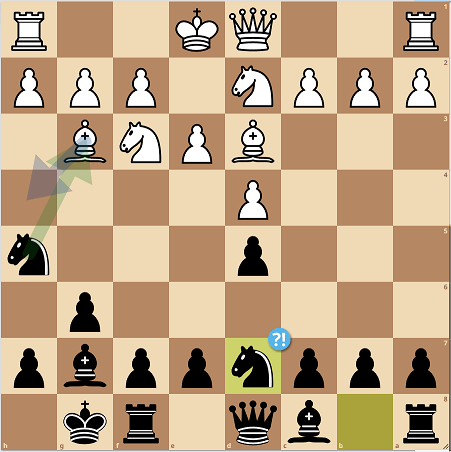
Of course, this makes perfect sense, since after he played his queen up to e2 – our third inaccuracy in a row – I did indeed take the bishop on g6, since I could then play the immediate e5, getting an excellent bishop, especially if he castles long.
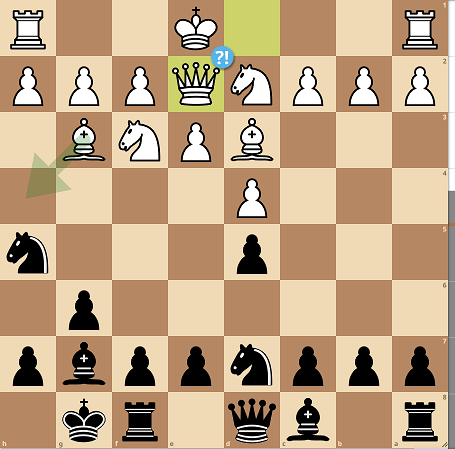
After the exchanges and with him long castling, I felt that I must have a very nice position. The computer agrees.
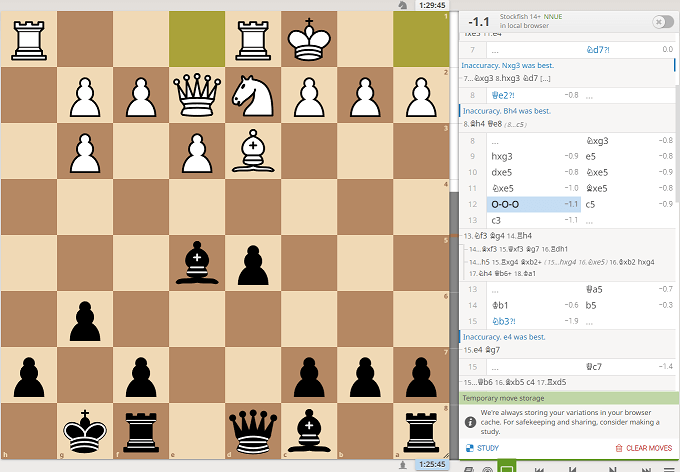
Eventually, after much calculation, I played c5.
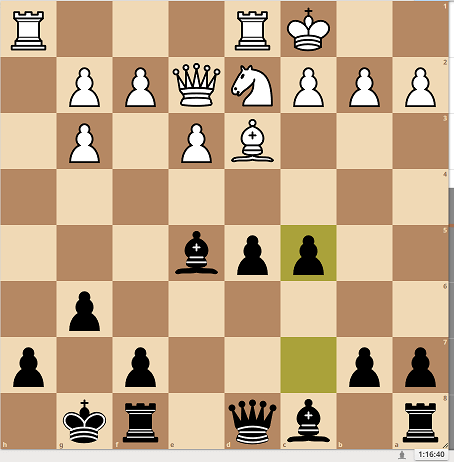
This is a fairly complicated position. As one example, if the line goes c5, Nf6 (attacking the bishop), I felt that the normal countertactic of developing the light squared bishop to g4, pinning the knight, wouldn’t work. He could play Rh4, preparing to double the rooks while also immediately threatening to just win two pieces for the rook, and I would have to exchange the light squared bishop for the knight, only improving his position.
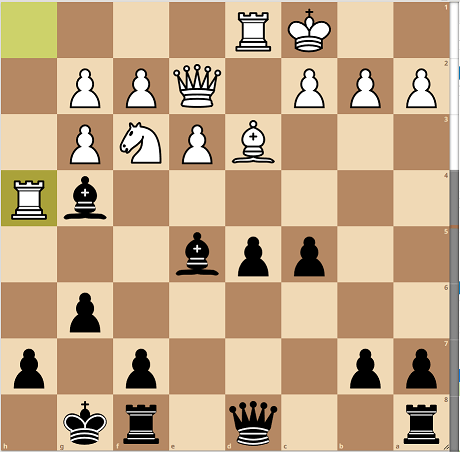
Sideline
The computer actually says that this position is still very good for black, but it involves sacrificing the bishop with Bxb2+, and it gets very tactical.

Back to the game. C5 carries with it the threat of c4. There are some nasty tactics in this position for both sides. I have the threat of Qb6 in some lines, which threatens Qb2#, and may win material. He has some pressure against my queen with the rook on the d file. Zurichh played c3, which blunts the bishop a touch, and potentially lets the queen on e2 defend along the second rank once the knight moves.
I kept looking at the sacrifice with Bxc3, but felt that it didn’t work, and was premature anyway. That’s a great bishop, and was for the remainder of the game. There’s no need to throw it away to open up the king, at least not yet.
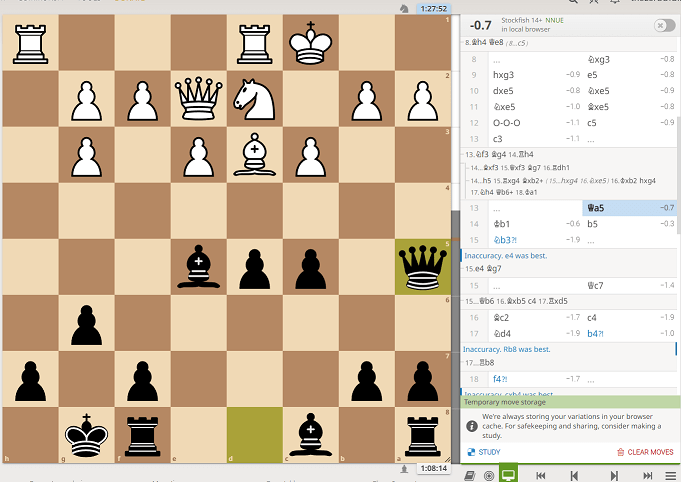
After almost ten minutes of thinking, I decided to swing the queen over to a5. After the natural Kb1 in response, I felt that I was on the cusp of having some tactic.
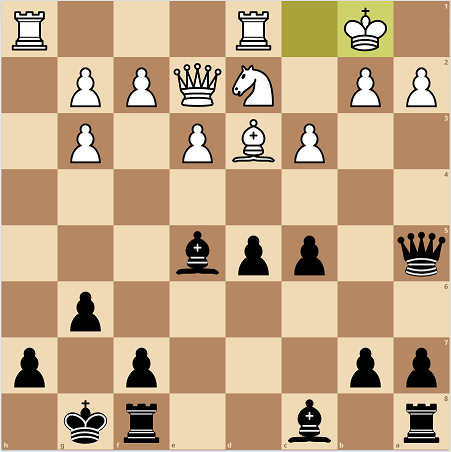
I thought for about thirteen minutes before playing the pawn sacrifice b5.
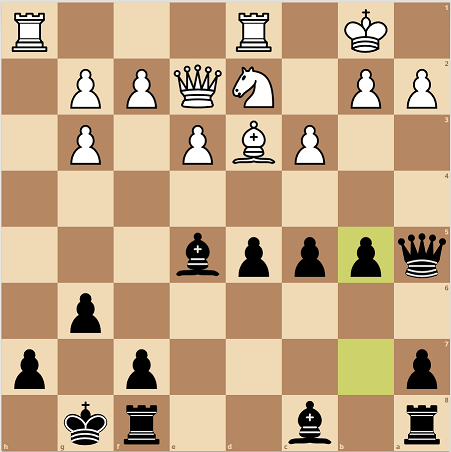
The computer thinks this move is on the cusp of an inaccuracy, although I somewhat disagree. It’s an extremely difficult move to meet, and the long term possibilities after he captures the pawn with Bxb5, not played in the game, can only work out in my favour. In fact the immediate capture of the pawn leads to either a loss of material, or checkmate. However, after the intermediate move Nb3, which he did play, it is a pawn sacrifice, although one with plenty of compensation.
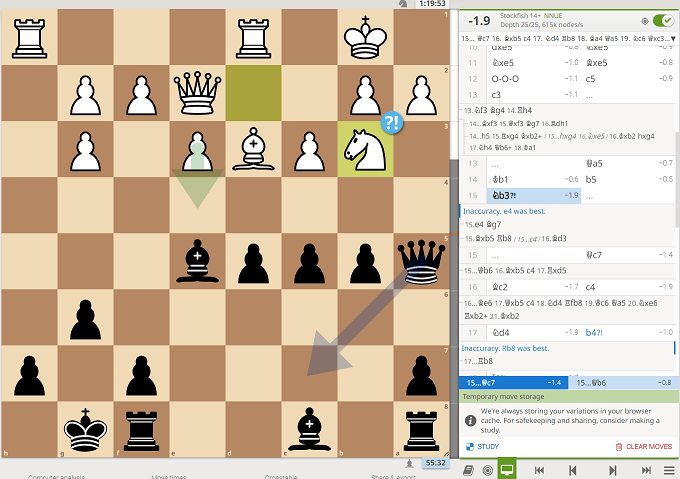
The computer says he should have ignored the pawn storm on the queenside and instead opened up the center, exploiting some tactics against the undefended bishop.
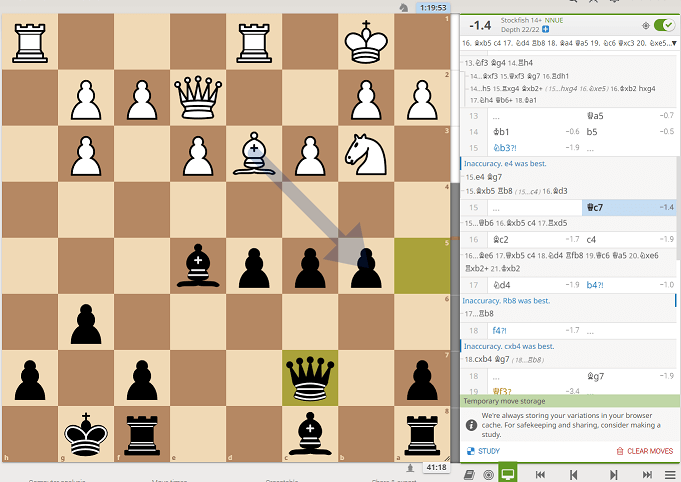
After a fifteen minute think, choosing between Qc7 and Qb6, I went with Qc7. I was sure that Qb6 didn’t work. The computer says it’s almost as good, but not with the natural line I would have played afterwards which would have given White an almost winning advantage.
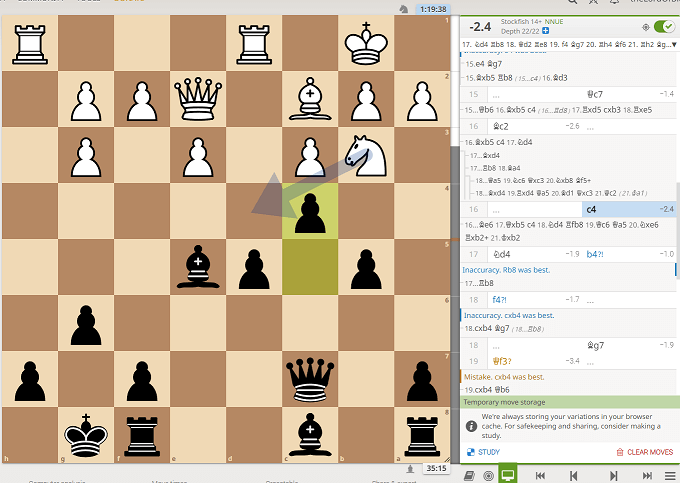
After my opponent surprised me by quickly playing Bc2 I started to be aware of my clock situation. I spent six minutes trying to make a few moves work, such as Be6, but I couldn’t figure it out. I played c4, fairly certain that the computer would tell me that I had missed something, but it in post-game analysis it now tells me that it’s the best move by far.
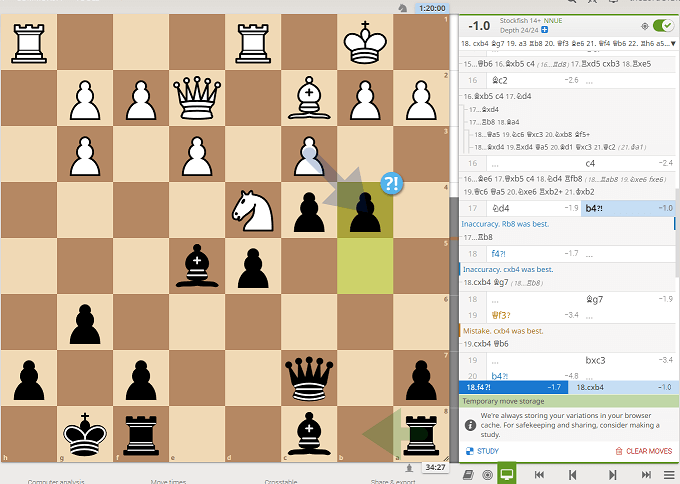
The same cannot be said for 17. b4, which it tells me is an inaccuracy. Ironically, I played this move in about one minute, almost certain that this move was best. I had calculated lines past this point already, saw that I could win back the pawn with a very open position around his king, and didn’t bother looking further. The computer recommends the simple preparatory move Rb8, which makes plenty of sense. However, I wanted to potentially keep my rook on a8, and slide the f8 rook over after developing the bishop. I also wanted to attack the pawns in front of his king as soon as possible.

My opponent played an inaccuracy right back, although this was an extremely unpleasant move to see. I had spent so much time focusing on the attack on his king, and him doubling rooks on the h file, that I hadn’t even considered f4. Once I saw it on the board, I was very worried about f5. I almost panicked, and strongly considered capturing his knight on d4. If that knight is snapped off then f5 turns into a pawn sacrifice, although it doesn’t really stop it due to the compensation of my open king.
Instead, I played the move that I am most proud of for the entire game. I simply retreated the bishop back to g7, having worked out that my attack is faster than his. I can afford to let him play f5, because fxg6 looks more dangerous than it is. Meanwhile I am crashing through towards his king, and if he plays cxb4, that’s not really a pawn sacrifice for all the same reasons as before.
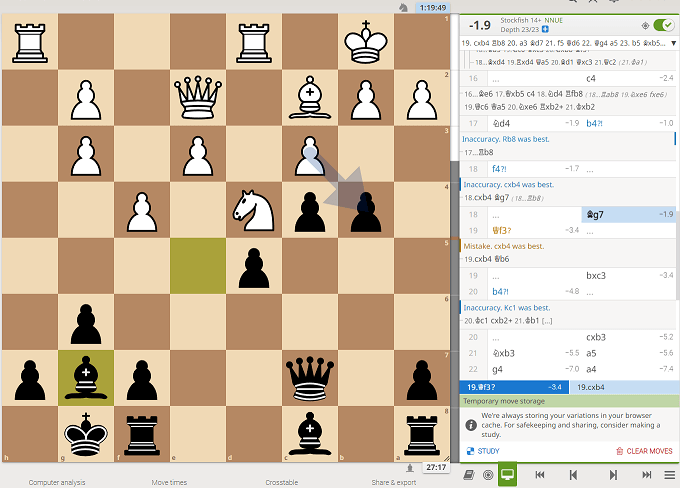
My most proud move. Although the computer tells me that Bxd4 is almost as good. Oh well.
At this point my opponent starts going seriously wrong. I was anticipating cxb4, or f5. The latter is quite soft, because he can’t allow bxc3. Qf3 on the other hand doesn’t immediately threaten much, especially because I have serious mate threats, and can for now ignore the attack on d5.
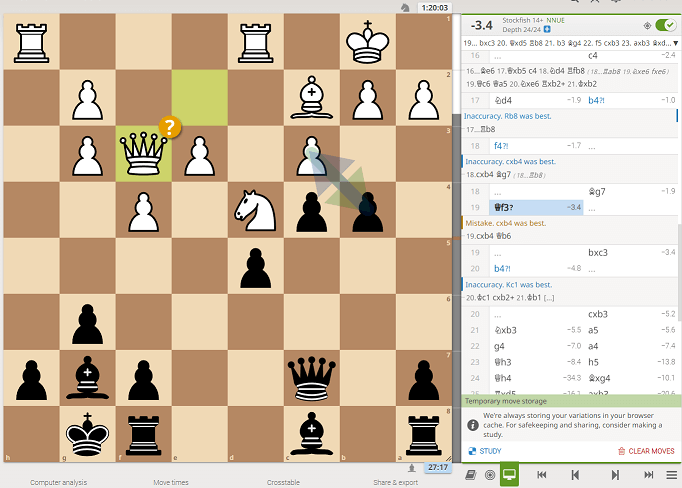
To be clear, this move prepares f5, and makes f6 potentially very unpleasant. It also may help his queen slide over to h6, as was played. It’s not a bad idea, it just doesn’t quite work.
After I capture on c3, my opponent plays the quite poor b4, which I feel is more than an inaccuracy. I quickly double check things, before capturing en passant. At this point I feel that I am definitely winning. I am up a pawn, while also putting the heat on his king, and his attack against mine is very vague.
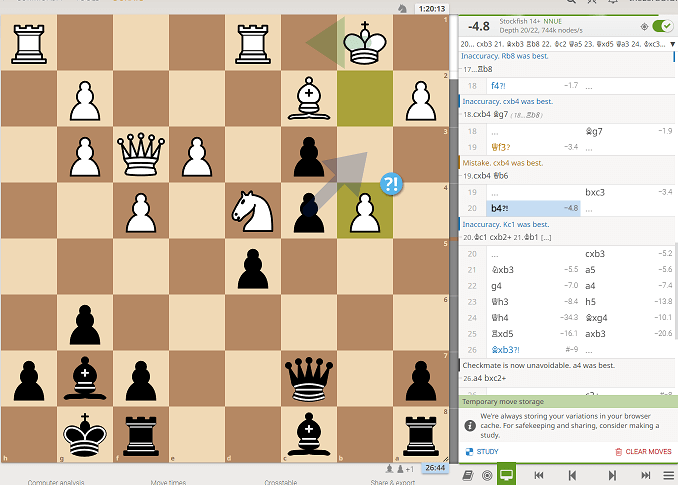
But it still requires accurate play to win, and my time is getting fairly low. After the recaptures I play a5, with a very serious threat of playing a4. During the game I thought this was an unstoppable threat, due to the additional threat of the queen checking him on the b file, before mating with Qb2#.
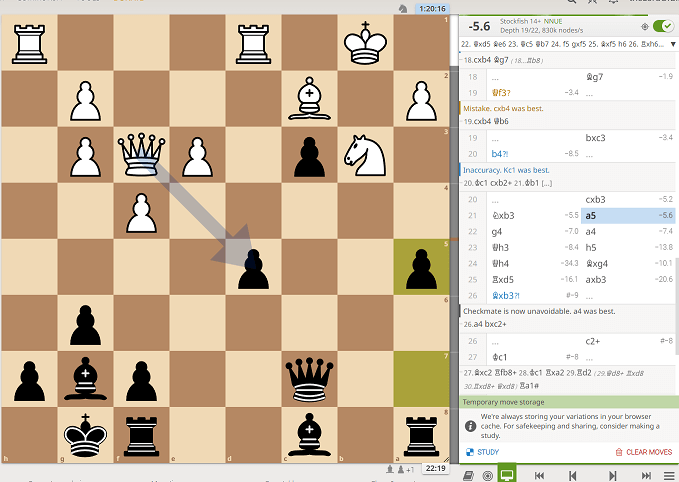 The computer wants him to capture the pawn on d5, a move I wasn’t worried about. This looks like it threatens the rook, but the light squared bishop can now be developed either to e6 or g4, hitting the rook, and my attack is overwhelming.
The computer wants him to capture the pawn on d5, a move I wasn’t worried about. This looks like it threatens the rook, but the light squared bishop can now be developed either to e6 or g4, hitting the rook, and my attack is overwhelming.
During the game I was very proud of myself for calculating out a few lines after Qxd5. For example, Be6 lets me win a piece. It looks like he can play Qxd5, Be6, Qc5! to exchange the queens, and free his knight. However, I saw Qb7, which simply wins the knight, as it can’t move, and even if the king moves to a1, the knight is still pinned because of Qb2#, therefore a4 is unstoppable.
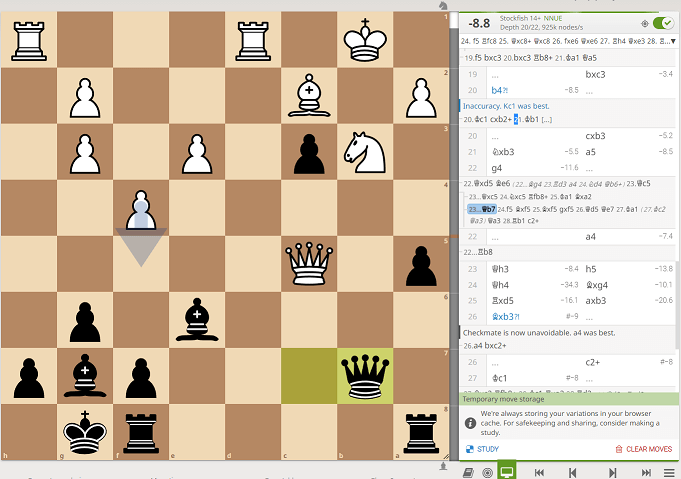
Sideline
What I didn’t see was f5 in this position. I’m still totally winning, but it’s a bit more complicated. But anyway, this is a sideline of a sideline. Let’s get back to the main game.

My opponent tried to organize an attack on the h file, but this was parried with h5. Sacrifices with the bishop on g6 simply don’t work, and the pawn cannot be taken because it is pinned by the queen. I was considering playing h6, which also works to stop the attack, and in fact the computer says that’s superior. But both moves are very much winning.
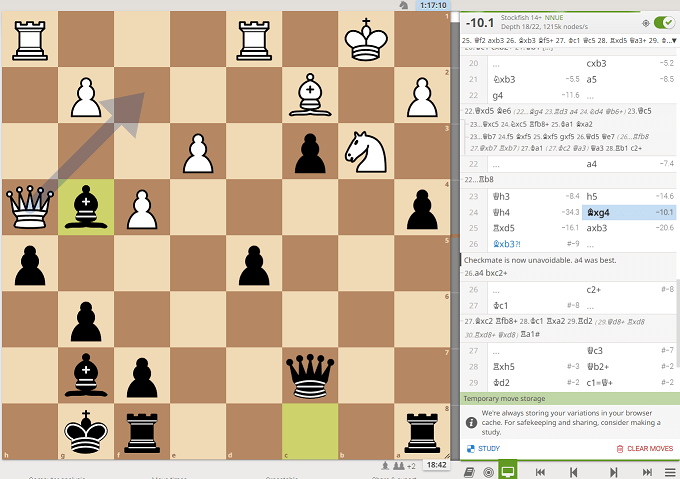
After he played his queen to h4, seen in the above position, I calculated taking the knight. I figured it was the best move, which it is, but developing the bishop, taking the g4 pawn, and shutting down the attack on the h file made Bxg4 a pretty easy practical move to play. Besides, I was low on time, and capturing the knight seemed a little risky. I still figured that he couldn’t move it because of the check + mate on the b file.

I had time to take the knight. Zurichh finally took the d5 pawn, but I calculated Rxh5 followed by g4, and felt I had it under control by just taking back gxh5 instead, totally shutting down the file for good. I was now up a piece and he didn’t have a hugely serious attack against my king, while I still had plenty of threats. Trading the pieces to an endgame would be more than enough, but after the recapture with the bishop, I decided to play the very sexy c2+. One cute line I saw went like this.
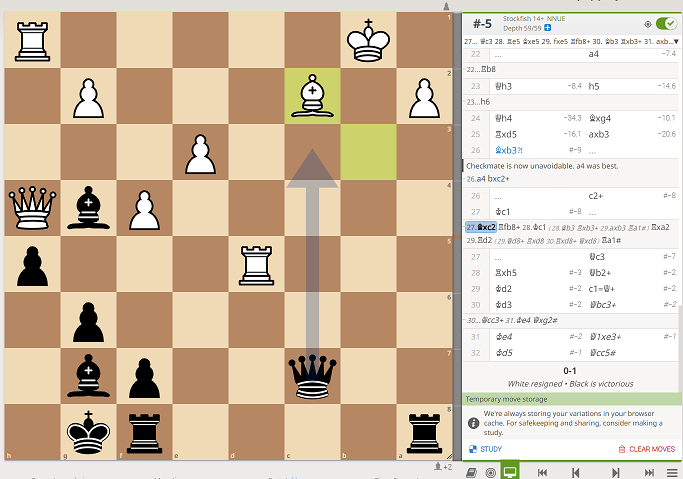
Sideline
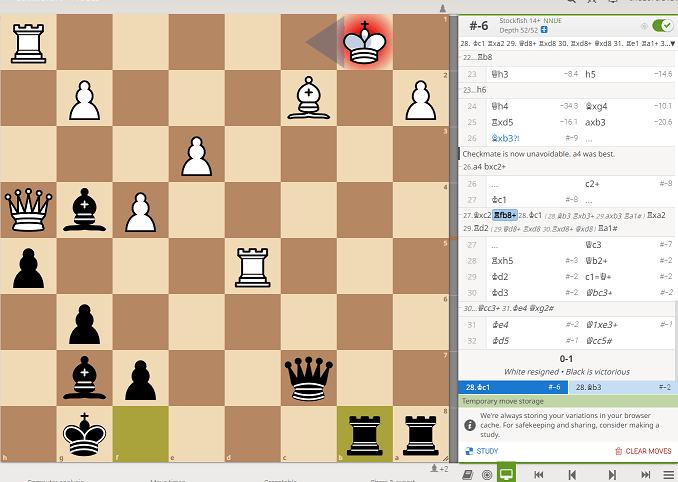
Sideline
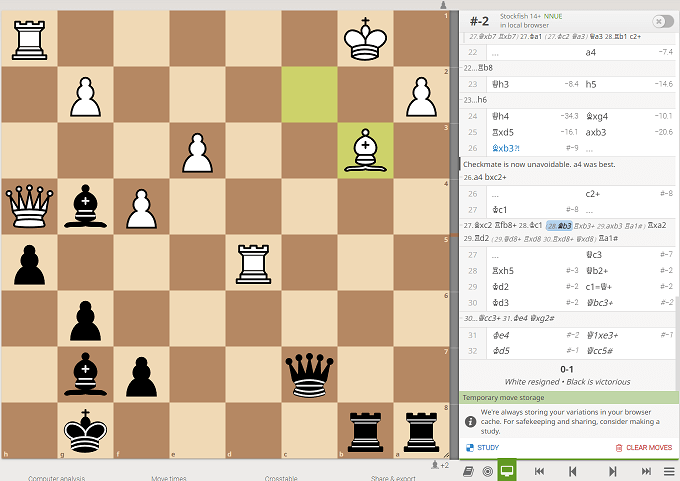
Sideline
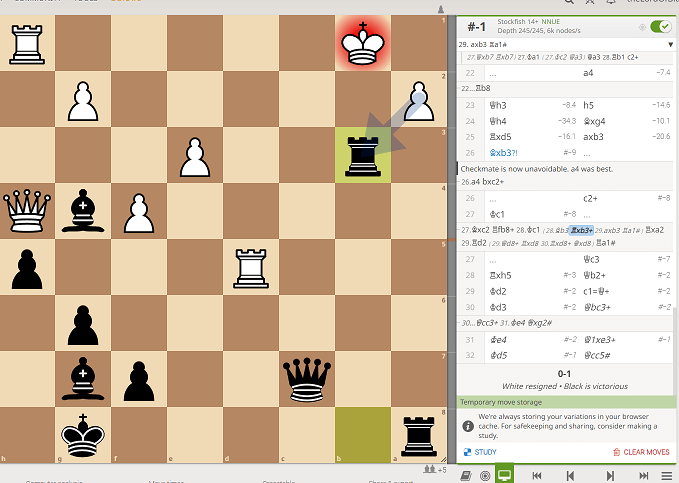
Sideline
Ending in this adorable rook and bishop mate.
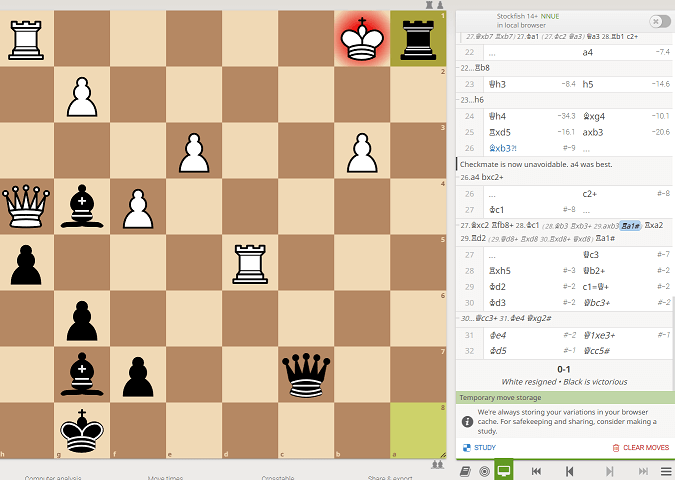
Sideline
In the game Zurichh sidestepped the check, which let me scooch the queen to c3, threatening an unstoppable queening. The rest of the game doesn’t need to be screencapped, as White’s position is hopeless. White resigned in the final position below.

Did I enjoy this game? Immensely. It’s very difficult to get long time control games online. As you can see with the times in the above image, I enjoy using up all the clock I have and then some.
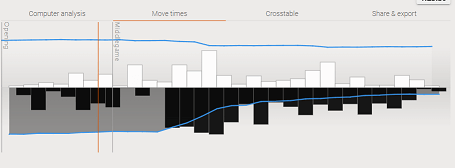
I also believe that my opponent played far too quickly. I don’t know if he was trying to put clock pressure on me, or if he had to go somewhere in a hurry, but there were plenty of complicated positions in this game that demanded lots of time to be used for calculation.
When factoring in the 30 second increment and 90 minute start time, my opponent used just 27:15 for the entire game. In contrast, I used 1:31:25, almost five times the amount of clock.
NOTE: Whoops. More like about three and a half times more clock.

2 inaccuracies. You love to see it.
Well, what else is there to say. Many other games have already been played, and I’m looking forward to the next round. The tournament couldn’t have started better.
Update:
Chess.com was less than impressed with my play.

Although I do think that this shows the limitations of computer analysis. Many of my mistakes were to miss the same idea – a prophylactic retreat of the dark square bishop – and some of the superior play is so far beyond my ability that computer analysis serves only as an idle curiosity, as opposed to any real learning opportunity.
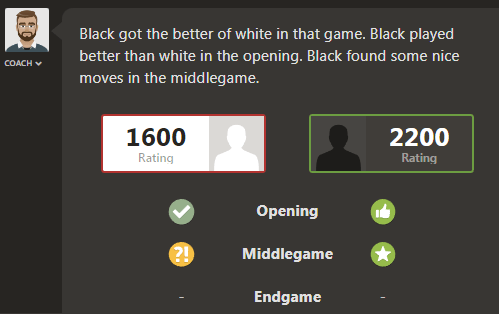
It was nice seeing them call me a 2200 player though.















Did you lose your horsey-guy?
Must nota cuz you won !